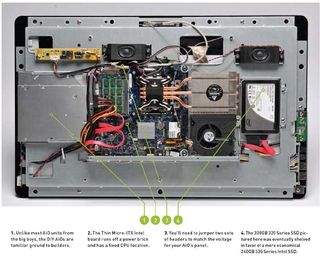How to Build: All-in-One PC

DIY AIO SHOWS A LOT OF PROMISE
Building the average desktop PC has long been a labor of love. Sure, in the old days you could save a serious chunk of change when you built your own rig, but these days it’s pretty hard to get a better price than a large or even medium OEM that buys parts by the container-full. That’s apparently not the case with all-in-ones, where it’s possible for builders to have a price edge. Lenovo, for example, offers a 20-inch AiO with the same CPU, 180GB SSD, and 4GB of RAM for about the same price as our Loop build. Granted, some OEMs offer a feature not available to this platform—a discrete GPU. That’s actually one of the holes we see in the current push for a DIY platform. Why no GPU provision? In the past, graphics vendors haven’t been the greatest at sticking to specs, so that could be the reason, but we think a unified AiO graphics spec is necessary if this category is really going to take off.
As to how our AiO performed—not bad. Our zero-point AiO is an Asus ET2701 INKI-B046C with a Core i7-3770S and GeForce GT 640M. Naturally, the $1,500 Asus, with its 27-inch panel, pricier CPU, and discrete graphics outshines our Loop build, but it’s a good reference for what our DIY AiO can do. Clearly, that extra $400 on the zero-point gets you more performance. Our DIY AiO performed respectably though, except in gaming. Intel HD4000 graphics are probably best suited for Portal 2–level and lower gaming. For today’s integrated graphics, Metro 2033 is way beyond its pay grade.
Overall, we’re pretty happy with the brave new world of DIY AiOs. Yes, it has some maturing to do, but giving enthusiasts the ability to customize an AiO to their own needs (or a parent’s needs) is a pretty strong argument for doing it yourself.
| Loop L5 | Asus ET2701 INKI-B046C | |
| 3DMark 11 | P449 | P1,937 |
| Metro 2033 (fps) | 10.9 | 29 |
| Adobe Premiere Pro CS3 (sec) | 857 | 404 |
| MainConcept (sec) | 985 | 919 |
| ProShow Producer 3.0 (sec) | 591 | 486 |
Best scores are bolded. Our zero-point AiO features a Core i7-3770S, 8GB of DDR3/1600, a GeForce GT 640M, and a 2TB 7,200rpm HDD. Metro 2033 is run at 1280x720, medium quality, DX10 mode, with 4x AA and 4x MSAA.
PC Gamer Newsletter
Sign up to get the best content of the week, and great gaming deals, as picked by the editors.
Most Popular

